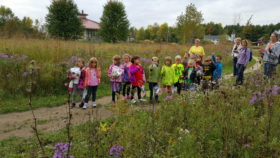
The past two weeks have been truly exciting at Crossroads at Big Creek. Under the supervision of professionals from Midwest Archaeological Consults, students, teachers, and citizen scientists have unearthed arrowheads (which are kind of dirt-colored) , pottery sherds (which are reddish dirt-colored, mammal bones, and turtle shells and tools, mostly gray.
Now we turn the calendar and it’s October—the month of color!
Colorful flowers, fruits and berries are much easier to see than Native American artifacts. We respond to color, and researchers believe that birds and insects may be even more sensitive to color than humans. Apparently, color awareness is related to food preferences.
Experiments reveal that gulls and domestic chickens are most sensitive in the yellow range of the spectrum. Owls see best in the blue range. This makes sense. Grains tend to be yellow; owl hunt in the dark when everything appears rather blueish.
Certain birds have no trouble locating red food. Watch a hummingbird in a garden or starlings in a cherry orchard if you doubt this.
When researchers dissect the eyes of birds, they find that daylight feeding birds—especially those that eat fruit—have a disproportionate number of color-receiving cells . They also have curious little red, orange and yellow droplets in the their retinas. One plausible explanation is that the droplets act like filters. If this is true (and not all scientists agree that it is) then birds would be more aware of the color red. To these birds, red fruits and berries would stand out like neon against the green of summer foliage.
Color vision is important to insects too. Some butterflies and beetles seem to respond to the color red, but researchers are quite sure that most insects so not see the same colors we do. Understandably, most experiments have been conducted on domestic honeybees, but it seems that honeybees and also our wild native bees do not see the colors red and orange. They are attracted to flowers that are yellow, all shades of purple, and a color we see as white, but actually is in the ultraviolet range of the spectrum.
In our upland fields and unmowed roadsides, fall brings a riot of colorful asters and goldenrod—yellow, white, and all shades of purple—all attracting pollinators like magnets.
It’s color season at Crossroads. Join a naturalist-led program or explore our three colorful properties on your own. Admission is free!

